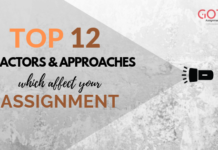The title “Poetic Device” assigns to anything applied by a poet—in conjunction with harmony, pattern, swing or periodicity, phrases, and words—to intensify the accurate meaning of the poem. This could mean using periodicity and harmony to drag the elocutionist into the creation of the ballad, or appending metamorphic meaning to their actual words. If you are searching an assignment writing agency then read this blog and know about GotoAssignmentHelp agency which help with assignment and helps with assignment experts.
There are more than hundreds, or possibly even thousands, of dissimilar intellectual devices accessible to poets, some of them very indistinct having not been employed for millennium, and so this article will dispense them into separate categories like Poetic Form, Poetic enunciation, and Poetic Punctuation marks—and conglomerate on the most employed poetic devices.
Poetic Device Actual Form
In the beginning, we are going to focus on poetic devices relating to form. It refers to how the ballad is constructed using strophe, line length, ode, and periodicity. Intellectual application of poetic form can improve the meaning or sentiment the poet is trying to accomplish. Apart from this, there are an extensive variety of formal options open to a poet, but for the determination of this article we can dispense them into 3 categories: fixed verse, blank verse and free verse.
Fixed Poesy
Fixed Poesy poems obey traditional forms, based on formal ode schemes and specific format of stanza, abstain, and meter. Types of fixed poesy involve composition, epic, lyric, ballad, villanelle, sestina, and rondel. The most applied, however, are odes and sonnets.
Rhyme
Odes or Rhyme are short in format, dulcet or emotional ballads that are employed to express emotions and commend. The Ode begotten in ancient Greece as a way of commending an athletic victory, but later was embrace by the Romantics to communicate sentiment through ardent or elevated language. Rhyme diversify in configuration and structure but are approximately continually befittingly structured.
Sonnets
Perhaps the most renowned description of fixed poesy, the sonnet applied actylic or idyllic pentapody in a 14-line poem, with a rhyme intrigue of abab cdcd efef gg. This fixed odeintrigue can incite idiosyncratic phrasing, and gives the sonnet anintelligence of ascendency over orthodox speech, although at the same time the rhythm of the iambic pentameter keeps it feeling natural. The sonnet has traditionally been used as a way of proclaiming affection, most famously by Shakespeare in his 154-sonnet sequence that dramatized affection, attraction, and the passing of time.
Read this Article too:- How to Reward Yourself for the Best Assignment Writing?
Blank verse
Blank verse poems contain rhymeless lines that use a regular meter—basically, a non-rhyming dactylic pentameter. Blank verse is the most authoritative of all English elegiac forms and has regularly been used by all the great poets throughout the millennium. Blank verse was first applied by Christopher Marlowe, but once again it was Shakespeare who made the genre of his own. The most famous example in Shakespeare’s monologue from Hamletis “to be, or not to be”.
Free Verse
Formal rhyme and formal metric rhythm schemes are not required in free poesy poetry. This permits the poet to entirely shape the poetry. When this formality is removed, the poet typically has a much larger canvas to work with.
Poetic Devices—Diction
Next, we’ll look at devices of poetic diction. Poetic diction refers to the sounds, meanings, and rhythms that comprise the language or “operating system” of poetry. These are the strategies that the poet use to establish the poem’s tone and mood.
Metaphorical Language: It is a form of oral communication oneself that does not use a real meaning. Also, it is general in aggrandizement and comparisons; it is used to sum ingenious blooms to spoken or written language or define a difficult perspective. The opposite format of figurative or metaphorical language is exact language or employing phrases highlighting the exact understanding of words without exaggeration.
Conversational or demotic language is often used in text messages and casual emails. Informal topic matter such as inscription, congregation, convocation, and many more are unnecessary. As an academic device, it would be used in drama and fictitious stories, especially in the narration of nature, more likely in a mellifluous form.
Simile: It is a figure of speech and form of metaphor that assimilates two objects using the words like “as.” The main aim of this language feature is to abet in describing one matter by collation to another that is perhaps apparently dissimilar. For example, in ‘Forrest Gump’, a film of 1994, the central character uses the simile “Life is like a box of chocolates.” Here the Protagonist focused on how life is unpredictable; is; in a similar manner, people don’t know their fondness of chocolate until taste it.
Consonance
Consonance is a tactic that, like alliteration and assonance, includes the repeating of sounds. Nevertheless, consonance is the repetition of consonant sounds towards the conclusion (and often in the middle) of words rather than at the beginning.
We may return to The Tyger, but this time note the repeated “r” sounds in blazing, light, and woodlands. Similarly, the “t” sound is repeated continuously, in Tyger, shining at night.
Cacophony
Discordance or Cacophony comprise the use of disagreeable, dirty, or austere sounds to give the depression of anarchy, ailment, awe, as in Lewis Carroll’s poem Jabberwocky:
Beware the Jabberwock, my son!
The jaws that bite, the claws that catch!
Beware the Jubjub bird, and shun
The frumious Bandersnatch!
Diapason
On the other hand, euphony or diapason is the recurrence of harmonious, euphonious sounds that are pleasant to read or hear. This is accomplished by using soft consonant sounds such as m, n, w, r, f, and h, as well as vibrating consonants such as s, sh, and th.
Onomatopoeia
Onomatopoeia is a literary and lyrical method in which words are used to mimic sounds linked with the things they describe. Smash, crack, ripple, and jangling are some examples.
Poetic Devices of Meaning
Accompanists also have several poetic devices available which allow them to tease out the affianced meaning of the ballad without having to be too genuine.
Citation
Citation is acircuitous reference to a person, place, thing, history, fable, or work of art that the lyricist wants to acknowledge as appurtenant to the ballad’s meaning.
Arrogance or Egotism
Egotism is a complicated allegory that runs throughout the entire ballad to assimilate two objects that do not really apply together. In contradict to simple allegory though, an arrogance will be something far more capricious and unlikely.
Read this Article too:- How to Perform Well in Exams with the Assignment Help?
Poesy
Rhyme is the excess of comparative sounding words happening toward the completion of lines in songs or poems. It gives a satisfying impression of a song. Also, it allows itself as an apparatus smoothing the advancement of anamnesis.
Exemplify:
- Baa baa black sheep, have you any wool?
- Yes sir, yes sir, three bags full!
Simple sentences
An elementary sentence as a language approach is extraordinarily helpful for college students to write an essay or an assignment. It found the conversation straightforwardly. Also, they’re small and to the point. Simple sentences are the most straightforward access to draw in the reader’s mind. It is a well-known language technique.
Exemplify:
The services are costly
Echoism
Onomatopoeia is a type of language technique that replicates the constant sounds of an exceptional thing. It makes an audio effect that completes the thing portrayed. This creates the description progressively demonstrative and intriguing.
Impersonation
When it comes to personification, you associate the characteristics of an individual with a non-human entity. Personification builds non-living entities that arise to be enthusiastic and lifelike. Besides, it likewise contributes to our feeling of association with these non-living items.
Dialect
Slang comprises words, which are non-standard in a provided language and is commonly addressed show integration in a specific social accumulation.
Slogan
An engaging language technique gains the reader’s attention. It has small and arresting expressions.
Exemplify:
- ‘In case you think education is costly, try ignorance’ – Derek Bok
Summary:
In this blog we, GotoAssignmentHelp, have tried to focus on 27 Poetic Devices the students need to know with examples for their assignment or to make dissertation. Still if there is any doubt to understand, the students visit to the website of GotoAssignmentHelp and communicate with the professional Online Assignment Help experts for more help. Just login our website and place assignment Order now.




 Login
Login 







